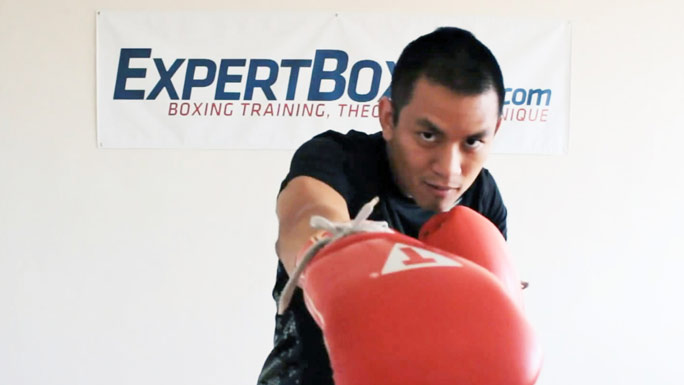
Isn’t it amazing how difficult even the most basic things can be?
We’ve all been there before. The first couple days seems exciting as hell and you can’t wait to come back. But then your beginner excitement dies down and training alongside other fighters, you start noticing all your deficiencies. And the harder you try, the more you feel unnatural at it.
Don’t you worry, everything you’re feeling is exactly what everyone else has felt before. What seems like a hundred mistakes really comes to only a few basic principles. Get those resolved and you’ll be holding your own against the “intermediate” guys in no time!
Here are the most common beginner boxing mistakes I see in the gym:
BEGINNER BOXING MISTAKE #1 – Too much upper body focus
Most beginners are overly-occupied with their upper body movements. Punches and blocks use only the arms, slipping movements use only the head, and their lower body (if they ever think of it) is used only for footwork. Dividing their body into separate parts and functions like this makes it easier to learn boxing in pieces but keeps you from being truly powerful!
Instead, all movements should combine the UPPER body and LOWER body together! Yes, the entire body moves at once for every movement. Punches will require leg movements. Small head movements will require small twitches in your hips and knees. Footwork will require upper body movement. Think about it…how weird would it feel to run without moving your arms? Or how about swimming using only arms but not legs? It just doesn’t feel right!
All body movements should use your upper and lower body!
The guys moving their lower and upper body IN UNISON will have more balance and more power. The feet are not only for footwork…they are also used for punches, defense, head movement—EVERYTHING! Even standing still in one place requires active feet. Without using your legs to put energy into your stance and punches, it’ll feel like you’re punching from a wheelchair.
The guys NOT using the lower and upper body together will always have a difficult time with balance and maximizing their power. Using only their upper body makes them over-reach and swing themselves off balance. To avoid losing balance, some will hold back or get tentative with their power. Others, insisting on swinging with full power anyway, will tense up their back muscles as a way of preventing themselves from falling over. This only makes them stiff, shortens their range, hinders mobility, burns more energy and still prevents them from throwing with full power. Same goes for footwork without using the upper body; lots of off-balance, wasted energy, less mobility, and decreased power.
Moving your upper and lower body together keeps your entire body perfectly aligned. Not only are your punches more powerful but you can clearly feel their exact range. No more reaching off-balance! Blocking punches no longer pushes you off balance because your arms now connect to your legs, giving you the solidity of the ground (like when you push a car).
Don’t get me wrong, moving the upper and lower body in harmony is one of the hardest parts about boxing and takes many years to develop that coordination. When you’re getting punched in the face, the last thing you think about is your legs. But with lots of training, you’ll eventually be able to move your entire body with every movement.
BEGINNER BOXING MISTAKE #2 – Not using the eyes
It doesn’t need to be said that you need to use your eyes to be able to fight. You have to see the target, time the target as it moves, and then aim your punches towards the target. On defense, you have to watch for incoming punches, follow-up punches, and also countering opportunities. Your eyes are absolutely essential for combat.
So why are we having problems doing what is so natural for everyone? Beginners have a huge problem with using their eyes because they don’t feel comfortable! Actually, that’s not even a beginner instinct, that’s a human instinct. We FLINCH and brace ourselves when we sense danger. Our eyes close as a way of protecting ourselves. Unfortunately in boxing, that instinct is counter-intuitive and doesn’t help at all. The more you’re being attacked, the more your eyes should be open to help you negate the attacks.
Should you find a comfortable beginner, they still might not be using the eyes! Just because their eyes aren’t flinching doesn’t mean they know what to look for. I’ll do my best to help you through both issues.
Train your eyes to see punches
This is a matter of technical training as well as psychological conditioning. You can improve very quickly if you do this everyday! Shadowbox with a partner. Both of you are “shadowbox-sparring” from a slight distance so no punches ever land. Make you practice at super slow speeds as well so you can REALLY see the entire movement of the punch. Spending time in front of a live opponent throwing punches makes you more familiar with fighting movements and move comfortable.
Beginners have no idea how little they understand punching movements. They often visualize punches from only 2 snapshots of the entire movement, the BEGINNING STANCE and the EXTENDED STRIKE. This is a huge issue when it comes to developing your fighting reflexes and getting comfortable with fighting. WHY?! It’s because in realistic combat, many punches are not thrown from the same stance and also don’t end at the same angle. You have to be prepared for punches starting and ending from different angles.
Not only that but there are also many snapshots from start to finish. It would be more ideal if your mind could visualize at least 5 snapshots of every punching movement. For example: a jab at start, a jab at the loaded position, a jab being released, a jab almost fully extending, a jab during impact, and then the same number of snapshots as the jab retracts and another punch is coming out. Yes, it’s a lot to train for. But this is what you must know to be COMFORTABLE!
What NOT to do – fight blind
The worse way to train is all-out speed, all-out intensity without any control. I’m sure you’ve seen it before. Two beginners swinging wildly with their eyes closed, both trying to attack and defend blindly. This is why I’m such an advocate of slow sparring.
See my other guides on how to use your eyes during a fight:
- Where to Look During a Fight
- Boxing Tip #3 – Eyes on Opponent
- How to Improve Your Fighting Reflexes
- Training Out the Flinch Reflex
BEGINNER BOXING MISTAKE #3 – Training faster than they can handle
Beginners are always trying to train, spar, or fight above their level. They’re going so fast that it not only affects their performance but also their ability to learn!
If you ever felt any of these things, there’s a good chance you are trying to perform way above your level:
- Boxing is too hard.
- Boxing is too tiring.
- Boxing is too painful.
- I don’t have enough power.
- I don’t have enough speed.
- My hands aren’t fast enough.
- My defense isn’t good enough.
- My footwork isn’t good enough.
It’s common nature for people to want to be better and to want to rush their way there. Training fast will help you learn fast and get better quicker, right? Unfortunately, no. Sparring above your level only helps you spar faster with the same bad technique. It doesn’t help you develop intelligent reflexes and to think faster. Again…like I already said, work on slow sparring.
Train at your level and you’ll never feel inadequate. RESPECT YOUR LEVEL. If you’re a beginner, work on beginner techniques at beginner intensity. Stay there until you’re absolutely comfortable. Then speed things up a bit, make it a little more challenging. But only a little. Keep it comfortable until you’re ready for the next step. That’s the only way to learn anything complicated. Going too fast too soon will not only overwhelm you, but you won’t learn anything. It’s also potentially very dangerous—this is boxing, remember?
BEGINNER BOXING MISTAKE #4 – Always forcing instead of feeling
If you splash the water, you’ll waste lots of energy and go nowhere.
If you feel the water and paddle with it instead of against it, you can go very far using very little energy.
Beginners lack the common sense of only doing what feels right. They will try to force all movements from all positions without any regard to how it feels. They’ll throw jabs that hurt their elbows. Or punch or move around in ways that lose balance. Or slip in ways that hurt their back.
Generally, they just have no idea of feeling their way around things. They’ll try to throw an awkward left hook when maybe a right cross is better from that position. Or they’ll try to slip even when it doesn’t work. They will try to force out whatever move that they want no matter what. They aren’t sensitive to their body or the situation in front of them.
Being able to read the situation in front of you takes time, experience, and maturity. These are things beginners don’t yet have but need to work on. Can’t get your jab past your opponent’s defense? That’s ok, try something else. Still doesn’t work? That’s ok, too. Just wait, be patient. Let the fight come to you. Openings are everywhere. You just have to take your time and look for them. Doing the same thing never works, but trying random things without studying the situation first doesn’t work either.
BEGINNER BOXING MISTAKE #5 – Not using the jab
Beginners don’t use the jab enough. And not only do they not use the jab enough, they also don’t use it without variety. They typically think of the jab as only being an opener to bigger punches and bigger combos. They fail to realize that the jab is the number one offensive tool, number one defensive tool, and also number one counter-offensive tool.
The jab is everything!
Many fighters don’t know how to make their jab functional. They feel their jab isn’t fast enough, isn’t strong enough…so instead, they rely on their right hand and left hook or other big punches. But the problem is none of those punches have the speed or reach that the jab has. None of those other punches can set things up the way the jab can.
Go back to really perfecting that jab. Make it snap! Make it crack. It doesn’t mean putting more muscle into it or trying to turn it into a left cross. You have to learn how to make one tiny little effortless movement lightning fast and powerful at the same time. It should be strong enough to break a nose. This little skill alone will do wonders for your boxing ability. Heck, if you can earn your opponent’s respect with a jab…imagine with your power punches can do?
The best way to get past beginner boxing mistakes?
The truth is: there’s no such thing as mistakes. Beginners do the best that they can. And they can’t do any better because they don’t know any better. Everything they’re doing is natural. It’s all part of the process.
Don’t let it get you down or make you feel uncoordinated, or untalented. Just be patient, work hard, take your time, learn, and enjoy the process. Really work on all the little nuances and before you know it…you’ll be moving around like a pro in there. Oh yeah, it also helps to have a good coach and good training buddies who will work with you at your level instead of overwhelming you and beating you down.
What were YOUR favorite beginner tips? What things help you the most when you were starting?





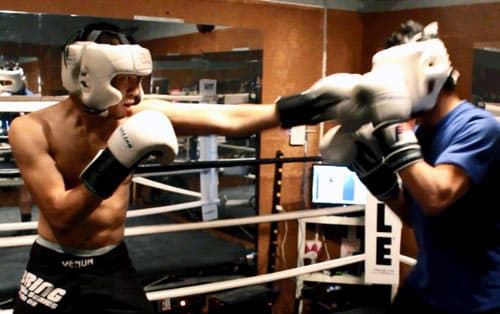

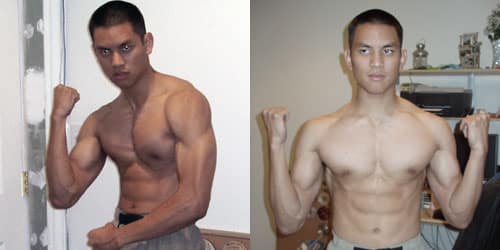
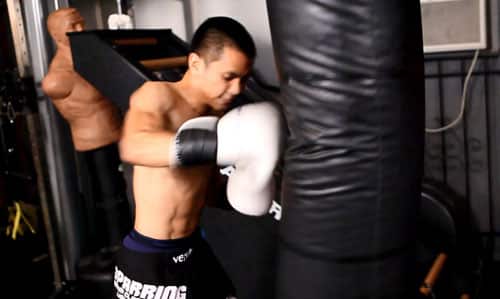
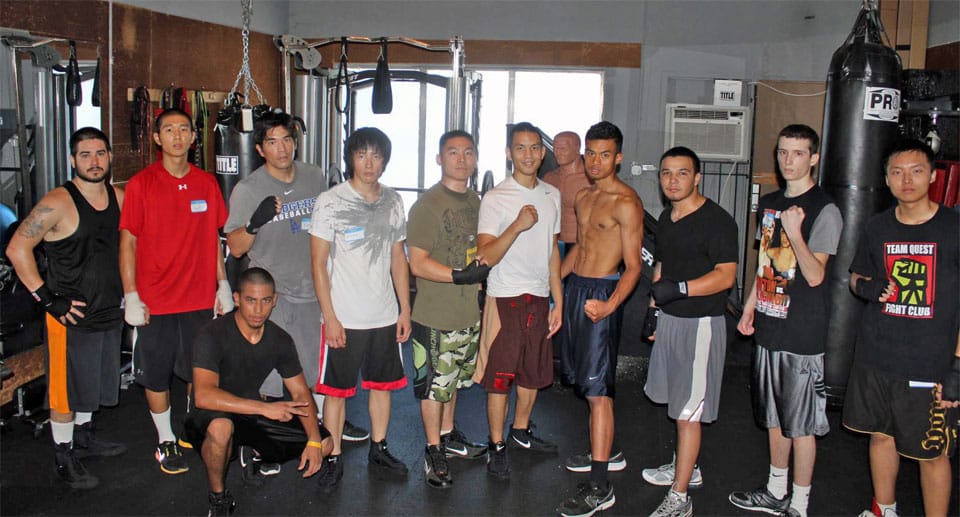
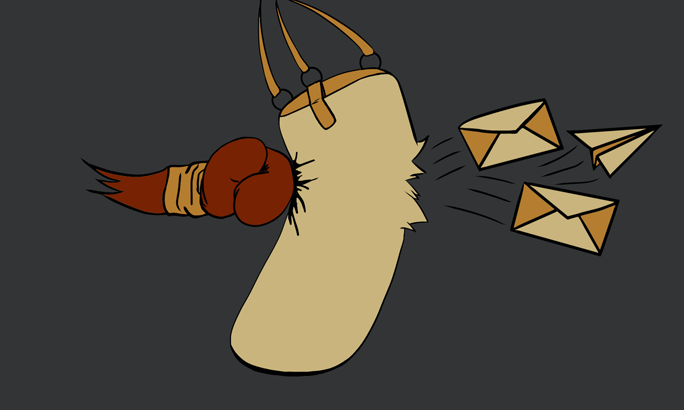
I agree, especially with #1. If there is any tip I’d give, it’s one that you stated before – to drop the hips (they can work on catching it later). I always have a beginner punch my hand as hard as they can as they feel fit, and then another with pivoting and dropping the hips – and they are confused – not only is it stronger in terms of feedback, but it’s also more effortless. Everyone tries to be ‘explosive’ when they need to be ‘implosive’ with a ‘centrifugal’ force like idea. I think that’s part of the beauty of boxing becoming a fight science rather than just a brawling match – learning anatomical efficiency.
In terms of #2, I think the mistake I see most often with not using the eyes is when the hook is thrown. People turn their heads with it (feels natural to do so), but then you lose sight of your target.
#3 and #4 go very well together. I believe EVERYONE should train at a slow pace as part of your routine. You cannot improve technique unless you are training slow enough to ‘feel’ and ‘see’ with a mirror all the parts that are going on. For example, when throwing a right hand, you have to feel the power generate from the foot, pivoting up the leg, the hips turning into it, the abs clenching, and then finally – the arm launching out, and even then, it’s part by part. The hard part about boxing is ‘feeling’ all the parts come online, and then it’s effortless. A great way to test technique is to do so after your arms are dead, and then you can realize that your arms are really just mechanisms of transferring energy that your lower body created.
And lastly, the Jab. 100% agree as well. I feel like I am the only person who spends 20-30 minutes of my day just practicing the jab in the gym (at least in mine). It’s the most important punch. But I can see how it might not matter if you aren’t ever planning to sparr or whatever.
Keep up the great content Johnny, I’ve learned a lot from your material over the years.
Great tips, Lar!
I do agree that many fighter’s turn their vision away with the hook. And the scariest part about turning your head away is that you have to turn it back for the right hand which puts you at serious risk of turning right into HIS right hand and getting yourself knocked out.
I love what you said about being the more efficient and technically-sound when you’re tired. I also feel when my body is dead tired is when I’m most able to free-flow my way around things…stop carrying tension in my body (since it’s so exhausting/limiting) and let the natural technique/movements flow!
Good to see you back Johnny.
Great to be back, more content coming! Do you have any special requests? 🙂
I know it’s not your normal thing, but do you feel like you’d want to do breakdowns of some of your favourite fighters? Like fighters you idolised and admired as you were still learning boxing and how they influenced you.
I’ve started doing some recently. Did you check out my guides on Canelo, Rigondeaux, Lomachenko? I would love to do more of other fighters!
Two things – “if you can do it slow, you can do it fast” got me to concentrate on getting the muscle memory right first and then working on speed/power. And “straight out, straight back” so the chicken-wing didn’t wreck my elbows! Great to see you back 🙂
As a boxing coach, I often find it important to emphasize the importance of Bruce Lee’s philosophy of “genuine expression” to beginners when discussing movement and punching. It never gets old seeing new guys come in emulating mayweather or hammad without any true understanding of how to box. Josh Kelly and Eubank jr seem to be popular too based on the stuff I see. I’m so tired of nobody being honest with themselves and accepting that you have to learn the basic fundamentals of before getting flashy or going hands fkn down.. It feels like I’m seeing more and more of this. Does anybody else here deal with these delusional types??
I love working with excited beginners. And honestly, the best way to teach them is let them spar. They’ll learn soon enough that being flashy and hands all over the place is not the right way to be. Experience is the best teacher.
Thanks for the fast reply !! Long time fan and internet student of yours! I agree completely with slow spar and do it myself almost daily. I try to get in front of new guys of all sizes asap. Unfortunately, our head coach is 40 yrs deep into running a boxing gym and poo poos all over the idea of anything other than hard sparring.. It’s so frustrating and has cost us a lot of potential talent. I’m a Loma kinda guy while he’s more Roberto Duran haha! Oil n water.. He and I are constantly at odds but the love of the sweet science keeps bringing it back lol. Anyway, thanks to you from all of us here and please keep up the amazing and inspiring work!
Lol, I came up the old school “sink or swim” method, too. And it does run out so much potential talent from the gym. I think it’s good to know how much they can take at first but then should adjust things to fit their natural temperament.
Bingo! Well put! I’m 42 and ex mil, so it’s a comfortable environment for me, but the generations coming up have to be approached differently whether salty dogs like it or not..or risk alienating some great athletes. When we beat guys up too soon, they rarely return. Even if it’s just their ego that’s bruised. It’s just a different time unfortunately. People are changing. Cosmetic self preservation is a growing concern for these young fighters in the dawn of selfies and rampant narcissism lol 😉
Great article perfect for all beginners.
I appreciate the effort and time you put into this website. Gratitude won´t suffice, that is why I keep practicing each article I read, from how to throw a jab, to footwork advice, about sparring, head movement, you name it.
What brings me down is that in the gym where I train there are almost no fighters, we have about 5 guys at most… And there is no other boxing gym. Still I give it my best on every drill, sparring and session, but I would LOVE to fight a different person at least each week, and not the same guy I sparred with yesterday.
Hey Kevin, thanks for stopping by. I get your pain my friend. For this reason, many boxers have to venture to other gyms to find sparring partners. It’s also common to be in a busy gym but with nobody in your weight class. Keep fighting the good fight!
This is the best article on basics of boxing that I have ever came across….each and every word is true to the core…
Hey Johnny hi Im à french boy ortoddhox but my left shoulder sometimes doesn’t support the constant use of jab and suffer some injuries so I decide to go southpaw…now I have 2 training in southpaw and the more difficult is move and coordination…do you have some trick and drills to improve my boxing in southpaw? Sincèrely yours